Family name: Taccaceae Dumort.
Synonym(s): [none]
Common name(s): tacca family
*Number of genera/species: 1/13
List of genera records in GRIN-Global
fruit or seed
Fruit a loculicidalloculicidal:
type of capsular dehiscence, opening longitudinally through the locules (compare septicidal)
 capsule or berryberry:
capsule or berryberry:
an indehiscent, fleshy fruit with one or a few to many seeds. The flesh may be homogenous throughout. Or, if the outer part is hard, firm, or leathery, referred to as an hesperidium. Septa are present in some, and the seeds may be arillate or with a fleshy testa.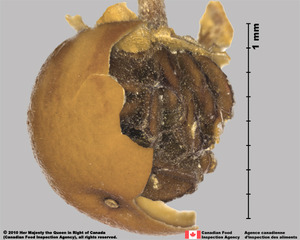 , 6–50 mm long, ovoidovoid:
, 6–50 mm long, ovoidovoid:
3D shape—ovate , subglobosesubglobose:
, subglobosesubglobose:
3D shape—almost globose
, or ellipsoidellipsoid:
3D shape—elliptic
, sulcatesulcate:
surface relief—having one or more elongate, relatively narrow and shallow depressions or grooves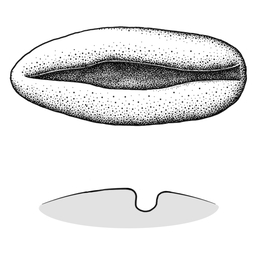 , tereteterete:
, tereteterete:
approximately circular in cross section; width and thickness approximately equal
 or angledangular:
or angledangular:
2D shape—having sides that meet at acute or obtuse angles
in transection, perianthperianth:
collective term for calyx and corolla of a flower
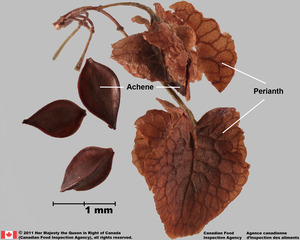 persistent, with 10–25 or many seeds. Pericarppericarp:
persistent, with 10–25 or many seeds. Pericarppericarp:
fruit wall or fruit coat
purple or brown, fleshy, ribbedribbed:
surface relief—wide, prominent, linear ridges that are generally rounded and longitudinally situated on the surface or ridgedridged:
or ridgedridged:
surface relief—raised, thick ridges, sharp edged or rounded, usually in a series that may cover the entire surface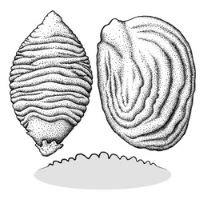 .
.
Seeds globoseglobose:
3D shape—more or less spherical to prismaticprismatic:
to prismaticprismatic:
like a prism; with sharp, definite angles and flat sides
, including reniformreniform:
2D or 3D shape—kidney-shaped or horseshoe-shapedhorseshoe-shaped:
or horseshoe-shapedhorseshoe-shaped:
3D shape—relatively slender and strongly compressed, the whole strongly curved over its length in a plane perpendicular to the direction of compression and forming an incomplete circle, the ends somewhat straighter than the rest and parallel or nearly so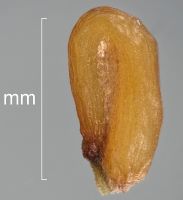 , compressedcompressed:
, compressedcompressed:
flattened; in grasses, used to denote compression (not necessarily flattened) either laterally or dorsiventrally
in transection. Seed coat brown, spongyspongy:
soft, light, discontinuous but cohesive, and somewhat resilient
, ribbedribbed:
surface relief—wide, prominent, linear ridges that are generally rounded and longitudinally situated on the surface or striatestriate:
or striatestriate:
surface relief—having fine, parallel lines, grooves or ridges . A thin, fleshy arilaril:
. A thin, fleshy arilaril:
(broad sense) appendicular structure that wholly or partly envelops a seed and is produced from or a modification of the funicle, raphe, or outer integument; usually fleshy or pulpy, sometimes spongy or tufted-capillate, often brightly colored is present in some species but not visible in dry seeds.
is present in some species but not visible in dry seeds.
Embryo rudimentaryrudimentary:
(of embryo) embryo is small and fills less than a quarter of the seed and can be variable in shapes, such as linear, spatulate, or oval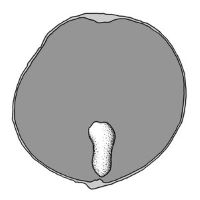 , minute, globoseglobose:
, minute, globoseglobose:
3D shape—more or less spherical or ovoidovoid:
or ovoidovoid:
3D shape—ovate , curvedcurved:
, curvedcurved:
(of embryo) linear embryo is curved into an arch or horseshoe with the ends far apart , basalbasal:
, basalbasal:
at or pertaining to the point of attachment; (of embryo) embryo occupies one end of the seed
, with laterallateral:
(of embryo) embryo lies along the side of the seed, generally towards one end; of, at, or from the side; in grasses, can refer to the sides adjacent to the dorsal and ventral sides
cotyledoncotyledon:
a primary leaf of the embryo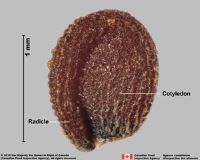 .
.
Endosperm copious.
| Fruit | |
| Type | capsulecapsule: a dry, dehiscent fruit derived from a compound ovary  , berryberry: , berryberry:an indehiscent, fleshy fruit with one or a few to many seeds. The flesh may be homogenous throughout. Or, if the outer part is hard, firm, or leathery, referred to as an hesperidium. Septa are present in some, and the seeds may be arillate or with a fleshy testa.  |
| Size range | 6–50 mm long |
| Shape(s) | ovoidovoid: 3D shape—ovate  , subglobosesubglobose: , subglobosesubglobose:3D shape—almost globose , ellipsoidellipsoid: 3D shape—elliptic |
| Texture | fleshy |
| Surface relief | ribbedribbed: surface relief—wide, prominent, linear ridges that are generally rounded and longitudinally situated on the surface  , ridgedridged: , ridgedridged:surface relief—raised, thick ridges, sharp edged or rounded, usually in a series that may cover the entire surface  |
| Color(s) | purple, brown |
| Unique features | Purple or brown, fleshy capsulescapsule: a dry, dehiscent fruit derived from a compound ovary  or berriesberry: or berriesberry:an indehiscent, fleshy fruit with one or a few to many seeds. The flesh may be homogenous throughout. Or, if the outer part is hard, firm, or leathery, referred to as an hesperidium. Septa are present in some, and the seeds may be arillate or with a fleshy testa.  with 6 ribs or ridges, usually with longitudinally ridgedridged: with 6 ribs or ridges, usually with longitudinally ridgedridged:surface relief—raised, thick ridges, sharp edged or rounded, usually in a series that may cover the entire surface  seeds. seeds. |
| Seed | |
| Shape(s) | prismaticprismatic: like a prism; with sharp, definite angles and flat sides , reniformreniform: 2D or 3D shape—kidney-shaped  , hippocrepiformhippocrepiform: , hippocrepiformhippocrepiform:3D shape—horseshoe-shaped , ovoidovoid: 3D shape—ovate  , ellipsoidellipsoid: , ellipsoidellipsoid:3D shape—elliptic , globoseglobose: 3D shape—more or less spherical  , oblongoblong: , oblongoblong:2D shape—much longer than broad with nearly parallel sides, corners are rounded  |
| Surface relief | ribbedribbed: surface relief—wide, prominent, linear ridges that are generally rounded and longitudinally situated on the surface  , striatestriate: , striatestriate:surface relief—having fine, parallel lines, grooves or ridges  |
| Color(s) | brown |
| Unique features | Ribbedribbed: surface relief—wide, prominent, linear ridges that are generally rounded and longitudinally situated on the surface  or striatestriate: or striatestriate:surface relief—having fine, parallel lines, grooves or ridges  seeds with a spongyspongy: seeds with a spongyspongy:soft, light, discontinuous but cohesive, and somewhat resilient seed coats. |
| Other | |
| Embryo | rudimentaryrudimentary: (of embryo) embryo is small and fills less than a quarter of the seed and can be variable in shapes, such as linear, spatulate, or oval  , minute, globoseglobose: , minute, globoseglobose:3D shape—more or less spherical  or ovoidovoid: or ovoidovoid:3D shape—ovate  , curvedcurved: , curvedcurved:(of embryo) linear embryo is curved into an arch or horseshoe with the ends far apart  , basalbasal: , basalbasal:at or pertaining to the point of attachment; (of embryo) embryo occupies one end of the seed , with laterallateral: (of embryo) embryo lies along the side of the seed, generally towards one end; of, at, or from the side; in grasses, can refer to the sides adjacent to the dorsal and ventral sides cotyledoncotyledon: a primary leaf of the embryo  |
| Nutritive tissue | endosperm copious |
Pantropical.
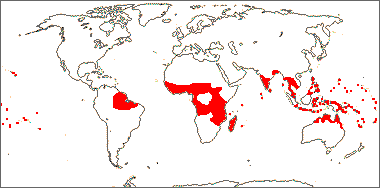
Distribution map courtesy of Angiosperm Phylogeny Website.
Baskin and Baskin 2021Baskin and Baskin 2021:
Baskin C and Baskin J. 2021. Relationship of the lateral embryo (in grasses) to other monocot embryos: A status up-grade. Seed Science Research 31 (3): 199-210. doi:10.1017/S0960258521000209; Carter 1962Carter 1962:
Carter S. 1962. Taccaceae. In: Milne-Redhead E and Hubbard CE, eds. Flora of Tropical East Africa. Vol 177. Crown Agents for Oversea Governments and Administrations, London UK. 3 pp.; Dahlgren et al. 1985Dahlgren et al. 1985:
Dahlgren RMT, Clifford HT, and Yeo PF. 1985. The families of the monocotyledons: structure, evolution, and taxonomy. Springer-Verlag, Berlin. 520 pp.; Flora of Australia 2021+Flora of Australia 2021+:
Flora of Australia. Australian Biological Resources Study, Canberra. Accessed January 2021–March 2024. URL: http://www.ausflora.org.au; Kirkbride et al. 2006Kirkbride et al. 2006:
Kirkbride JH, Jr, Gunn CR, and Dallwitz MJ. 2006. Family guide for fruits and seeds, vers. 1.0. Accessed September 2020-January 2022. URL: https://nt.ars-grin.gov/seedsfruits/keys/frsdfam/index.cfm .; Kubitzki et al. 1990+Kubitzki et al. 1990+:
Kubitzki K et al., eds. 1990+. The families and genera of vascular plants. 7+ vols. Berlin etc.; Stevenson and Loconte 1995Stevenson and Loconte 1995:
Stevenson DW and Loconte H. 1995. A cladistic analysis of monocot families. In: Rudall PJ, Cribb PJ, Cutler DF, and Humphries CJ, eds. Monocotyledons: Systematics and Evolution. Royal Botanic Gardens, Kew.; Takhtajan 2009Takhtajan 2009:
Takhtajan A. 2009. Flowering plants: Second edition. Springer Nature, Switzerland. 871 pp.; Watson and Dallwitz 1992+Watson and Dallwitz 1992+:
Watson L and Dallwitz MJ. 1992+. The families of flowering plants: descriptions, illustrations, identification, and information retrieval. Version: 6th Accessed September 2020-September 2022. URL: delta-intkey.com; Zhengyi et al. 2004+Zhengyi et al. 2004+:
Zhengyi W, Raven PH, and Deyuan H. 2004+. Flora of China [online]. 25 vols. Science Press, Beijing China & Missouri Botanical Garden, St. Louis USA. Accessed January–March 2024. http://flora.huh.harvard.edu/china/
*The number of genera and species is based on Christenhusz and Byng 2016Christenhusz and Byng 2016:
Christenhusz MJM and Byng JW. 2016. The number of known plant species in the world and its annual increase. Phytotaxa 261 (3): 201-217. https://doi.org/10.11646/phytotaxa.261.3.1, which may differ from the number of genera in GRIN-Global.